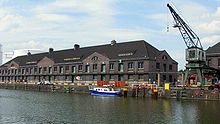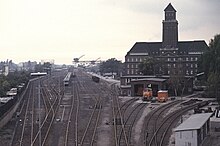Westhafen (Berlin)

The Berlin West Harbor is an inland port in the district Moabit of the district center .
description
With an area of 430,000 square meters, the Westhafen is the largest port in the city. It is divided into two parallel port basins . It is connected to the Spree and Havel via the Westhafenkanal and the Berlin-Spandauer Schifffahrtskanal ( called the Hohenzollern Canal in a westerly direction ) and is integrated into the national waterway network between the Elbe and the Oder . The Westhafen is an important transshipment and storage area for inland shipping . For onward transport of goods by rail, it is connected to the Berlin Ringbahn , among others, via the Hamburg and Lehrter freight depots and the Moabit freight depot . The goods are transported to and from the city by truck via the A 100 city motorway . With the train stations Westhafen and Beusselstraße , S-Bahn and U-Bahn are available for local public transport .
West of Beusselstrasse is the Berlin wholesale market with a meat wholesale market and fruit courtyard.
history
Planning and installation at the beginning of the 20th century
After the first plans were drawn up around 1900, the city of Berlin acquired the required land from the Evangelical Johannesstift in 1906 , which at that time was still located in Plötzensee . After lengthy preparation and against the initial resistance of the Royal Prussian State Railways, construction of the West Harbor did not begin until 1914, but there were considerable delays due to the war . BEHALA (Berliner Hafen- und Lagerhaus AG) was founded as the operating company in 1923 . On September 3 of the same year, a first part of the western harbor was inaugurated. The secret building officer Friedrich Krause was responsible for the planning of the entire system and the execution of the civil engineering work, while the architect Richard Wolffenstein and his partner Wilhelm Cremer were responsible for a substantial part of the warehouse and administration buildings, the granary and the port facilities .
With the subsequent expansions, especially between 1924 and 1927, the Westhafen was expanded to become the second largest inland port in Germany. Between 1939 and 1943, the port received another mighty grain silo based on plans by the architect Ernst-Erik Pfannschmidt . Before that there was already a customs warehouse.
The port cranes required for loading work ran parallel to each other on several rails on both sides of the port basin. The last ones in front of the warehouses had only one rail on Hafenstrasse, the other was permanently attached to the long buildings at the height of the first floor, which can still be seen today.
After 1945
After the Second World War , 60 percent of the port facilities were destroyed. Of 35 cranes only six were still intact, but some of these were also lost due to the dismantling of reparations . The damage was repaired by 1950 and the Westhafen was then further expanded for transhipment between barges, railways and trucks. Until the reunification of Berlin , the facilities also served as the Senate Reserve , which was created for times of crisis .
In 2001, the youngest of the original three harbor basins was filled in again to create more space for the shipping company building. As part of the Berlin port concept from 2001, the port received a container loading station , a roll-on-roll-off system and a landing stage for inland cruise ships . Some of the listed port buildings have been modernized, further extensions and extensions are planned or already under construction.
German Unity Transport Project No. 17
The Westhafen is part of the controversial traffic project German Unity No. 17 for ecological reasons . With the expansion of the waterway connection Hanover - Magdeburg - Berlin, inland vessels with up to 2000 tons and with a discharge depth of up to 2.80 meters can reach the Westhafen.
Use of the port facilities
Since 1997 the Prussian Cultural Heritage Foundation has been using most of the old granary, which was converted into a warehouse. The Prussian Cultural Heritage Foundation also has other users: the Secret State Archives and the newspaper and children's and youth book departments of the Berlin State Library .
In some of the historical warehouses there are furniture stores and workshops next to wholesalers' salesrooms . Such a conversion has a certain tradition. As early as 1926, the automobile manufacturer Ford rented a warehouse in which up to 300 workers assembled model T ("Tin Lizzy") vehicles from individual parts, which were taxed lower than complete cars when imported. Production in Berlin was given up in April 1931 and moved to the new plant in Cologne .
Inland navigation church

From 1968 to 2009 there was a ship's and harbor church at Westhafenstrasse 1 in a former shop building. It is the successor to a floating church used by the boatmen's community until 1943. In June 2009 the community moved to the newly opened harbor chapel on the BEHALA site, which was set up in the intermediate building next to the granary. On January 28, 2017, the Association for Church Welfare for River and Canal Boatmen e. V. Berlin started its activity.
West Harbor Canal
The three-kilometer-long connection to the Spree, initially the New Connection Canal , now known as the Westhafen Canal , which began in 1938 , was not completed until 1956 due to the war. The canal straightens and shortens the route to the Charlottenburg lock .
See also
literature
- Friedrich Krause : The western port of Berlin . In: Zentralblatt der Bauverwaltung , year 43 (1923), pp. 410–414, 421–429. Digitized
- Jörg Raach: 80 years of BEHALA - between then and now (1923–2003) . BEHALA - Berliner Hafen- und Lagerhausgesellschaft mbH (publisher). Berlin 2003
Web links
- Entry in the Berlin State Monument List with further information
- Alt-Berlin.info - The Westhafen in the Pharus plan from 1921
- Kathrin Chod, Herbert Schwenk, Hainer Weisspflug: Westhafen . In: Hans-Jürgen Mende , Kurt Wernicke (ed.): Berliner Bezirkslexikon, Mitte . Luisenstadt educational association . Haude and Spener / Edition Luisenstadt, Berlin 2003, ISBN 3-89542-111-1 ( luise-berlin.de - as of October 7, 2009).
- BEHALA - with aerial view of the western port
- IHK - logistics center Westhafen
- The West Harbor in Berlin - pictures at medienarchiv.com
Individual evidence
- ↑ Hans Aschenbrenner: September 3, 1923 - The opening of the West Harbor . In: Berlin monthly magazine ( Luisenstädtischer Bildungsverein ) . Issue 9, 1998, ISSN 0944-5560 , p. 90-93 ( luise-berlin.de ).
- ↑ Calendar sheet October 2nd, 1930 . someday
- ↑ We're moving! Website of the Protestant Schifferkirche
- ↑ Looking back on 117 years of association activity by the Schifferkirche. Website of the Protestant Schifferkirche
Coordinates: 52 ° 32 ′ 24 ″ N , 13 ° 20 ′ 5 ″ E






